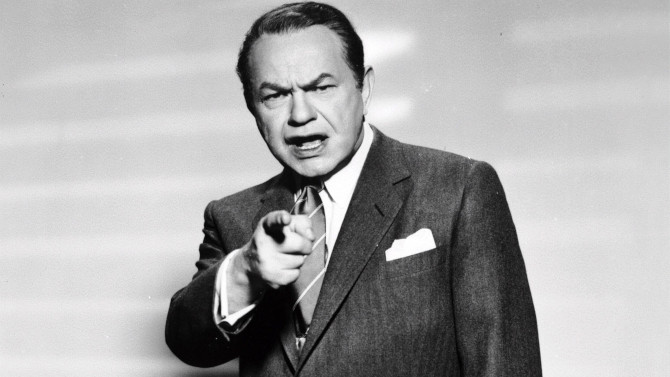
A Law Unto Themselves
The front door to an apartment swings open... an unseen figure walks through the living area and approaches a beautiful blonde woman wearing a robe as she walks around the bathroom... he then deliberately empties the barrel of his revolver into her – this is the jarring cold opening to the film noir Illegal (1955), and one thing is for sure, it knows how to grab your attention. Funnily enough, this was the third adaptation of the 1929 play “The Mouthpiece” by Frank J. Collins, following Mouthpiece (1932) and The Man Who Talked Too Much (1940) – and they say movies are remade too much today. Flash to Victor Scott (Edward G. Robinson), a district attorney who is wise to all the angles and is graced with a silver tongue. With an unyielding desire to win (he got it from growing up and fighting his way out of the slums), he argues every case like it is his last.
-

A Barrel of Bloody Laughs
Lock, Stock and Two Smoking BarrelsSeptember 18, 2016Numerous robberies, black market sales, an underground high stakes poker game, and traffic violations abound in Guy Richie’s first motion picture – Lock, Stock and Two Smoking Barrels. Featuring the now iconic director’s signature style, Richie fills his intricately plotted, multifaceted storyline with fast paced editing, even faster paced dialogue, his oddball sense of humour, rich personas, and eye-catching style that consists of both sepia tones as well as vivid colours. Though the tale consists of many varied characters, Eddy (Nick Moran), Tom (Jason Flemyng), Soap (Dexter Fletcher) and Bacon (Jason Statham) make up the main gang. They are a group of friends that have been together since childhood and have been small time crooks for nearly as long.
-
Star Pick with Sean Astin
 I Love L.A. . . . ConfidentialL.A. ConfidentialSeptember 13, 2016
I Love L.A. . . . ConfidentialL.A. ConfidentialSeptember 13, 2016A few months back, I was fortunate enough to speak with Sean Astin. For those of you who have been living under a rock for the past three decades, Astin has starred in a plethora of memorable classics. With his mother being the late Patty Duke (Oscar winner – The Miracle Worker), he had large shoes to fill. Starting off with a bang, Astin, in his early teenage years, took on the role of Mikey in Richard Donner’s 1985 fantasy flick The Goonies. Following this, he has continued making wonderful motion pictures, including 1993's Rudy, 1998's Bulworth, as well as playing the beloved role of Samwise Gamgee in Peter Jackson’s The Lord of the Rings trilogy. He also showed off his comedic talents in 2004's 50 First Dates and 2006's Click. He has also conquered the television world, portraying Lynn McGill in ‘Day 5’ of 24 (a very strong season), as well as Jim Kent in Guillermo del Toro’s The Strain.
-
Star Pick with Steve Coulter
 Cool Pick for Dog Days of SummerDog Day AfternoonAugust 30, 2016
Cool Pick for Dog Days of SummerDog Day AfternoonAugust 30, 2016Back in April of 2016, I sat down with actor Steve Coulter (twice). He was one of the special guests attending the Cornwall and Area Pop Expo (CAPE). The character actor, who has had a plethora of interesting roles over his career, is perhaps best remembered as the kind hearted, intellectual Reg Monroe (the mastermind behind the walled compound of Alexandria) on the ever popular series The Walking Dead. He has also had a recurring role as Amishman Elijah Bowman on the standout Cinemax series Banshee. On the film front, he has worked with horror maestro James Wan an impressive five times, including as Father Gordon in The Conjuring and its sequel, as well as playing Carl in Insidious: Chapter’s 2 and 3. He also portrayed Roger, a lawyer, in one of my favourites – Mr. Brooks. Mr. Coulter was gracious enough to be interviewed twice, once as part of a local Cogeco special, while on day two of CAPE, we chatted all things Banshee. Check out both meetings below to hear some great stories from all the things mentioned above, as well as his favourite film.
-

Annie Get Your Gun
Gun CrazyMay 16, 2016I am sure most of you have heard of the classic 1967 crime flick Bonnie and Clyde. Perhaps a film that is lesser known and is also based off of Great Depression bandits Clyde Barrow and Bonnie Parker (though the two characters have different names) is the legendary 1950 film noir Gun Crazy – which, when viewed, will clearly be seen as a precursor to the Warren Beatty and Faye Dunaway offering.
-
Vigilante Justice USA/UK Style
 Dirty HarryGet CarterMay 6, 2016
Dirty HarryGet CarterMay 6, 2016Dirty Harry, starring the legendary Clint Eastwood, has to be one of the most iconic characters in film history. Eastwood truly brings the essence of Harry Callahan to life, delivering a gritty performance that captures the hero’s gruff, no nonsense ways and vigilante-style justice. In 1971, the same year Eastwood starred in Dirty Harry, Michael Caine was cast as the lead in a British motion picture called Get Carter, which carries many of the same themes.
-

Snatch and Grab
Snatch.April 3, 2016The first thing that came to mind after watching Guy Ritchie’s 2001 crime film Snatch was that it must have been a bugger to write. Ritchie, who both scribed and directed the movie, concocts a motion picture that feels like an amalgam of film noir, a British crime caper, a boxing flick as well as a comedy – all thrown onto the screen by some sort of high powered rocket launcher.



